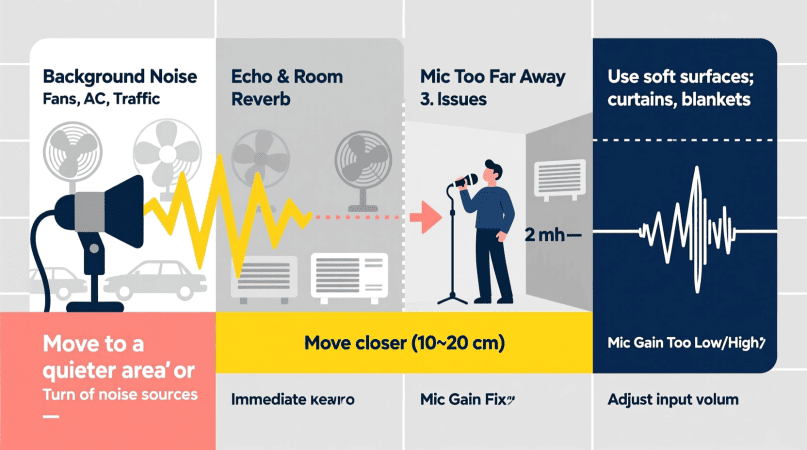
You’re ready to check your pitch, but the detector keeps bouncing between notes or showing unstable readings. The culprit is usually noise. In loud or echo-heavy rooms, background sounds can overpower your voice or instrument, confusing the algorithm. The good news is there are simple fixes that help your pitch detector lock onto the right frequency.
Why Pitch Detectors Struggle in Noisy Environments
Pitch detection works by tracking the fundamental frequency of your sound. When a room is full of extra noise—chatter, hums, reverb, or even playback from speakers—the detector sees competing peaks. Instead of clean data, it gets a messy mix, which makes the reading unstable or completely wrong.
Common issues include:
- Background chatter adding extra peaks.
- Room reverb smearing the true signal.
- Low-quality microphones picking up everything equally.
- Gain set too high, exaggerating noise along with your pitch.
Quick Fixes for Noisy Rooms
1. Use the Right Microphone and Placement
- Choose a directional cardioid mic that focuses on the source, not the background.
- Place it close to your mouth or instrument—this boosts the signal-to-noise ratio so the detector hears you clearly.
2. Control the Room Noise
- Turn off fans, TVs, or other constant noise sources.
- If you can’t escape the environment, face a wall or soft surface to reduce reflections.
3. Adjust Gain and Input Settings
- Too much gain makes noise louder; too little weakens your signal.
- Find a balance where your main tone is clear without clipping.
4. Use Headphones to Prevent Feedback
If your mic hears playback from speakers, it adds another layer of noise. Headphones keep the system focused only on your direct sound.
5. Use Tools with Noise Visualization
Some detectors show a frequency spectrum so you can see what’s interfering. Our real-time pitch detection tool makes noise peaks visible, helping you adjust in seconds. Singers can also use the singing pitch detector to monitor stability in cents, even in less-than-ideal spaces.
Quick Troubleshooting Table
| Problem | Likely Cause | Quick Fix |
|---|---|---|
| Detector flickers wildly | Background chatter | Use cardioid mic, reduce room noise |
| Octave jumps | Reverb masking lows | Face soft surfaces, lower mic distance |
| Flat or unstable readings | Mic clipping | Adjust gain, step back slightly |
| No reading at all | Weak input signal | Bring mic closer, boost input carefully |
FAQs
Q: Why does my tuner bounce between notes in a noisy room?
Because it’s detecting both your signal and competing background frequencies.
Q: Can I fix unstable readings without buying new gear?
Yes—try mic placement, noise reduction, and adjusting gain first.
Q: Which mic works best for noisy environments?
Dynamic cardioid mics like the Shure SM58 are more resistant to background noise than condensers.
Q: Does reverb affect pitch detection?
Yes. Reflections blur the fundamental, making detectors jump or misread notes.
Pitch Detector is a project by Ornella, blending audio engineering and web technology to deliver precise, real-time pitch detection through your browser. Designed for musicians, producers, and learners who want fast, accurate tuning without installing any software.
